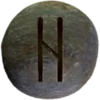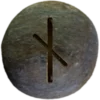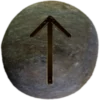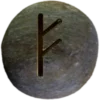Last Updated on March 14, 2025



Symbolism and Meaning
Hagalaz (ᚺ) (pronounced “HAH-gah-lahz”), represents hail and destruction. Some spell it Hagall or Hagal. In Old Norse, “Hagall” (HAH-gahl) also meant hail. The Anglo-Saxon and Younger Futhark forms resemble the Latin “H.”
Hagalaz connects to chaos and natural forces. Hail starts as water, freezes, and then melts. This cycle reflects change and hardship. Many see it as a rune of destruction before renewal. Like hail, its impact is sudden and unavoidable.
Runic poems link Hagalaz to hardship. The Old Norwegian Rune Poem calls hail “cold grain.” The Anglo-Saxon Rune Poem describes it as a storm’s gift. It signifies tough times that shape character.
Hagalaz in Historical Texts
The Poetic Edda and Prose Edda do not mention this rune directly. However, Norse myths show hail’s destructive power. In the Völuspá, Fimbulvetr brings endless frost and snow. This mirrors the harsh nature of Hagalaz. ![]()
Sagas also describe hail’s role in battle. In Heimskringla, hailstorms disrupt armies. This shows Hagalaz as a force beyond human control. It reminds warriors that nature, not men, holds true power.
Uses in Magic and Divination
People used it for protection and control. It could break patterns or end stagnation. Some carved it on weapons to invoke chaos. Others used it to ward off enemies.
In divination, Hagalaz signals disruption. It warns of unavoidable hardship. Unlike other runes, it rarely has a positive side. It demands resilience and adaptation.
Hagalaz appears in bind runes and talismans. Some paired it with Jēra (ᛃ) for controlled change. Others combined it with Nauthiz (ᚾ) for endurance. These combinations balanced its harsh energy.
Modern Interpretations
Today, this rune still symbolizes hardship. Many see it as a rune of necessary destruction. Some link it to personal growth through struggle. It represents the idea that challenges forge strength. Artists and writers use it in stories of transformation. Its meaning resonates with those facing major life changes. It remains a powerful symbol of chaos and renewal.
Runes associated with Hagalaz
The Nauthiz (ᚾ, “NOW-thiz”) and Isaz (ᛁ, “EE-sahz”) Elder Futhark runes connect to Hagalaz through hardship and transformation. ![]()
Nauthiz represents necessity and resistance. It signals struggle but also inner strength. This rune warns of delays but encourages perseverance. Like Hagalaz, it marks difficult times that forge resilience. The shape of Nauthiz resembles two crossing branches, symbolizing obstacles and endurance.
Isaz embodies stillness and patience. It represents ice, a force that halts movement and demands caution. It reminds one that nature’s power cannot be controlled. Isaz teaches self-discipline, urging focus during stagnation. The rune’s single vertical line mirrors frozen water’s unyielding nature.
Both runes emphasize hardship’s role in growth. Nauthiz challenges through struggle, while Isaz demands stillness. Alongside Hagalaz, they reveal how chaos, resistance, and patience shape fate.
Its Power in Asatru
This rune signifies sudden, uncontrollable change. Asatruar see it as a force that breaks stagnation. Hagalaz teaches resilience. Hail destroys crops but melts into water, bringing new growth. This reflects cycles of hardship and renewal. Asatruar view it as a test of strength.
This rune also connects to wyrd, the unfolding of fate. It reminds Asatruar that hardship shapes destiny. The gods endure struggles, and so must their followers.
Ritually, Hagalaz clears obstacles. Some use it in meditations to embrace necessary destruction. Others invoke it before major life changes. This rune warns against resisting change. Asatruar honor its lesson: hardship refines the soul. Like hail turning to water, struggle leads to wisdom.


